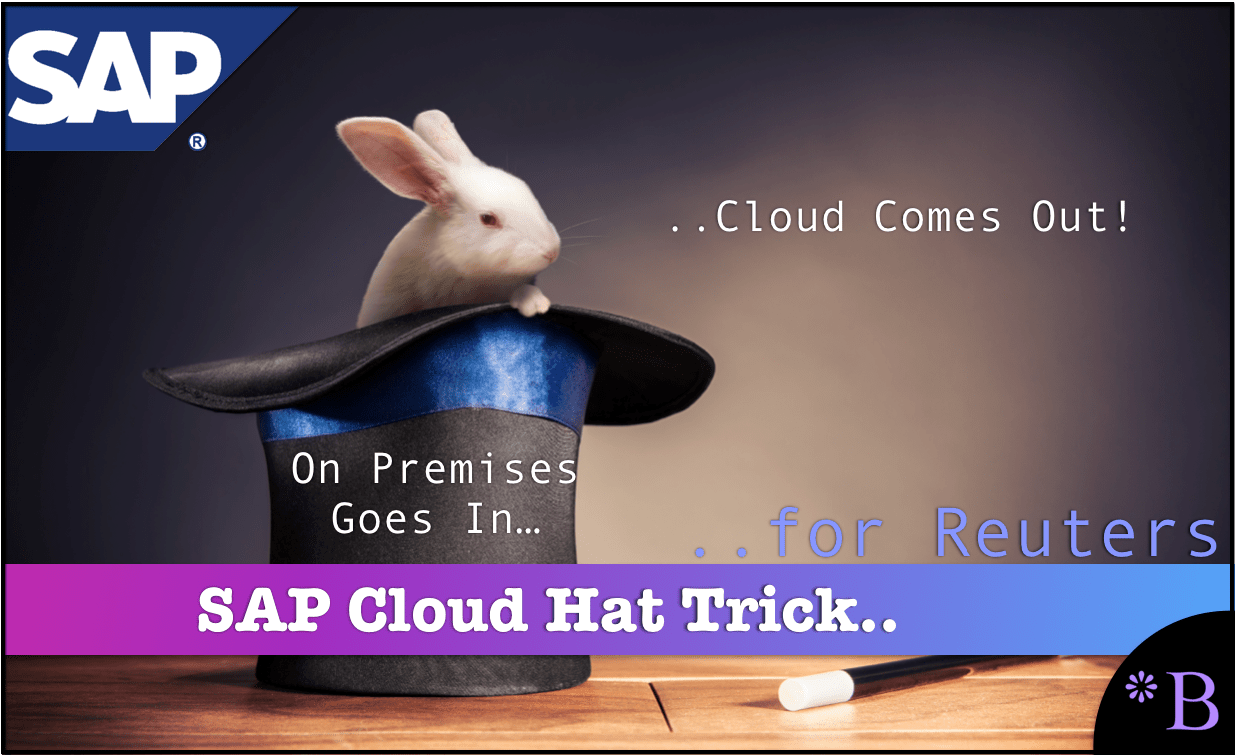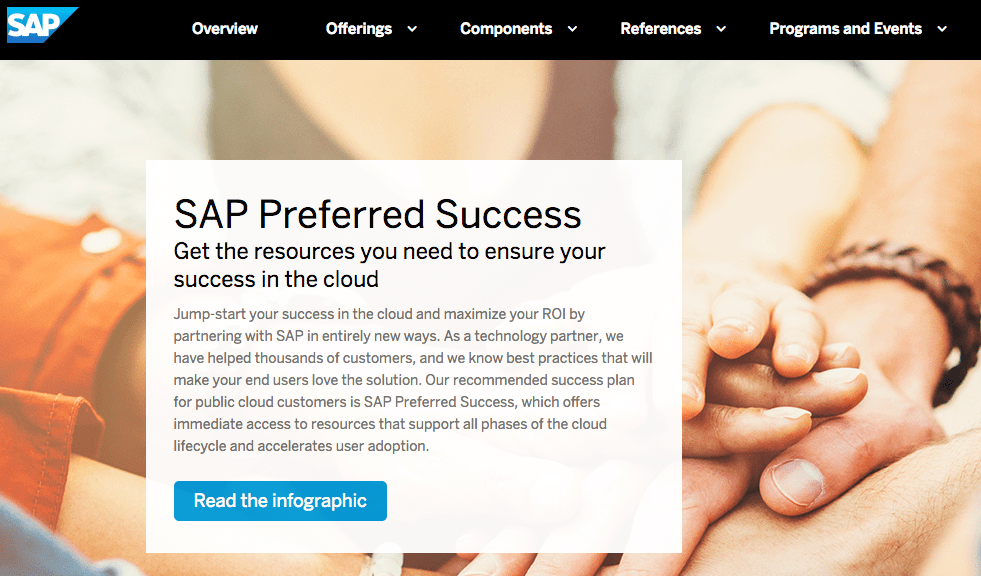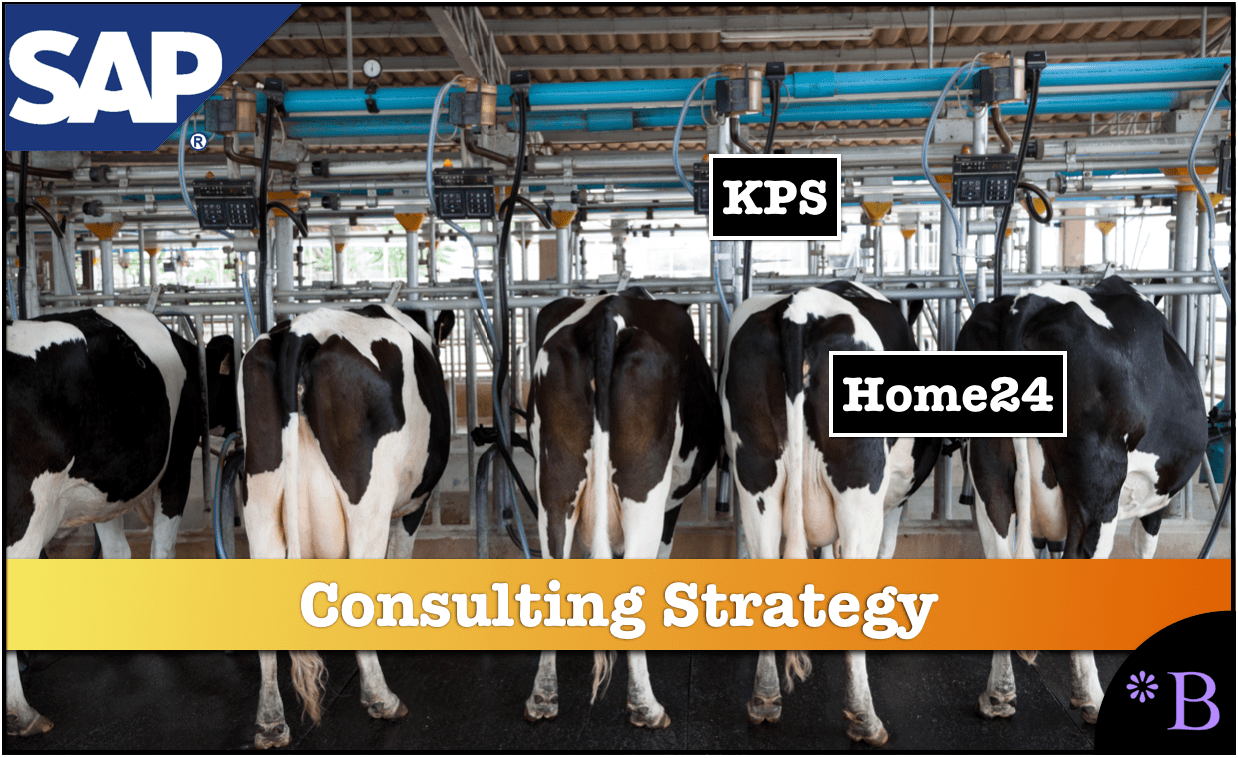SAP’s Hat Trick: Confusing Cloud and On Premises S/4HANA
Executive Summary
- SAP has a very deliberate way of confusing people about S/4HANA (cloud or on-premises) they are speaking of.
- This is illustrated in this Reuters article.

Video Introduction: SAP’s Hat Trick: Confusing Cloud and On-Premises S/4HANA
Text Introduction (Skip if You Watched the Video)
Reuters published the article “SAP Vows to Ease Cloud Transition; German Customers Less Keen.”
This article repeats the claims by Wall Street that increased cloud business will increase profits and serves to repeat SAP marketing assertions that SAP wants Wall Street to think are true.
Reuters also presumes that SAP’s products are truly cloud, which they are not, and the overall article is at least in part designed to confuse SAP customers between the on-premises version and cloud version of S/4HANA. Reuters, which does not employ any writers qualified to evaluate statements from SAP, uses a highly unreliable source in SAP’s Uwe Grigoleit, whose inaccuracy I have covered in other articles. Uwe makes inaccurate claims about S/4HANA, which Reuters repeats unthinkingly as the Reuters reporter both knew nothing about SAP and would not want to contradict an executive from a company that most likely advertises with Reuters.
You will learn about our review of the Reuters article for accuracy.
Our References for This Article
If you want to see our references for this article and other related Brightwork articles, see this link.
Notice of Lack of Financial Bias: We have no financial ties to SAP or any other entity mentioned in this article.
The Article Quotations
We take excerpts of the most essential parts of the Reuters article and comment on them below.
ECC to be Phased Out by the Middle of 2020?
The article begins by stating the poll results of SAP customers but then moves into accepting SAP’s statement about its goal.
“In SAP’s native Germany, which accounts for 14 percent of global sales, only 10 percent of customers are willing to move core processes into the cloud, according to a survey by the DSAG user group that hosted a gathering in Leipzig this week.
SAP, Europe’s most valuable technology company, is trying to accelerate the adoption of its premium S/4HANA cloud suite, which it wants to replace software run on local servers that it plans to phase out by the middle of the next decade.”
That will not happen. And at this point, it’s a ridiculous goal to publish because it has a zero percent chance of occurring. (As per a review of this article in 2022, that statement has still not come true).
Companies will be running ECC on-premises for quite a few years past 2025.
If you do the math regarding uptake and produce a forecast with an increasing adoption rate, you still end up with most of SAP’s customers on ECC when the clock ticks to midnight on Jan 1st, 2025.
SAP can either deny those customers’ support and hand the support contacts over to Rimini Street or others or continue to honor the support contract at roughly a 90% margin. And Pablo Escobar will tell you that turning away from a 90% margin is difficult, as we covered in the article How do SAP and Oracle’s Support Profit Margins Compare to Pablo Escobar?
The Cloud for Increased Margins?
Reuters says something strange about the interplay between cloud and margins.
“Achieving scale as a platform company is vital for SAP to expand its margins while weaning itself off the juicy up-front license fees earned on its traditional enterprise planning software used to run finance departments and supply chains.”
Cloud will not allow SAP to expand its margins. Cloud will shrink SAP’s margins. This is because the cloud reduces the vendor’s account control over the account. SAP’s margins are based on its control over media/consulting/information providing entities and its lock-in. But that is only if the vendor really is offering cloud, which the mega-vendors usually don’t. For example, SAP locks clients into 6-year contracts, which is not cloud — nor is single tenancy cloud.
A big part of SAP’s overall margins is found in its support. Usually, a cloud subscription is supposed to include support; I don’t recall running into the opposite of this.
However, SAP is set to challenge this with their “cloud forward thinking” as they charge support for cloud offerings.
This support model for the cloud is currently being formulated, but notice the following quotation from SAP’s support website.
“SAP Preferred Success is currently available for SAP SuccessFactors, SAP S/4HANA Cloud, SAP Cloud Platform and SAP C/4HANA Suite.”

The SAP Preferred Success support cost is 20%, which is very similar to the 22% (base) support cost for SAP on-premises. SAP has a lower support level than this for the cloud called SAP Enterprise Support. However, the contract term has changed, so customers cannot leave after a few years.
If you read the documentation for SAP Cloud Platform, it states that support is included. But the overall costs of the SAP Cloud Platform or just SAP Cloud have changed. At one point, the SAP Cloud was free. That was to bump up the numbers of people “using it” for Wall Street cloud credibility.
But now, the SAP Cloud has jumped in the price for everything except the free developer version, which is a trial.
Long story short, SAP is trying to re-create its on-premises support model for its cloud products. And SAP is easing its customers into being used to paying support for the cloud. Because SAP funds all the major media outlets and IT analysts and has an enormous consulting partner network, they can do this without being called out for it.
When SAP does a lot of things related to policy and pricing changes, mainly if it makes the scenario worse for the customer, SAP does not announce them. You bring up the website later, and something dramatic has changed; that is how you know. And since parties write nearly all the information written about SAP with allegiance to SAP, these changes receive very little coverage.
SAP Wants to Reduce their Customer’s Costs?
Reuters gets a very amusing quote from Uwe Grigoleit.
“We want to reduce both the costs for our customers and the time it takes to implement the new software,” Uwe Grigoleit, global vice-president at SAP, told Reuters in an interview on the sidelines of the SAP user conference.”
SAP has never in its history been concerned with the costs incurred by its customers or the implementation speed. If SAP were concerned with implementation speed, they would have removed many consulting partners with very long implementation timelines, but SAP will partner with any consulting company.
So why the sudden concern now?
That is because there is no concern.

SAP will not only not provide negative reinforcement to SAP consulting firms that extend project timelines. They support consulting firms like KPS that actively milk customers, as is covered in the article The Hidden S/4HANA Home24 and KPS Failure.

Uwe Grigoleit wins yet another Golden Pinocchio Award for his statement regarding SAP’s concern with project duration.
How Many Customers will Covert to S/4HANA?
And those surveys are always an overestimate. Similarly, inaccurate survey results can be obtained by asking people how likely they will lose 10 pounds in the next year. The actual is always less than the projected with estimates like this.
“Only 41 percent of core SAP customers surveyed expect to complete the transition to S/4HANA by 2025, the year the company plans to stop servicing its workhorse Business Suite enterprise software.”
SAP will extend its support beyond 2025, with no ifs, ands, or buts about it.
The Rest Want to Keep Core Processes on Their Own Servers?
Is the term force feed the right term for the cloud?
The way SAP and Oracle do it, and the answer is Y-E—SSSSSSSS!
“The rest want to keep core business processes running on their own servers, DSAG board member Marco Lenck told the conference, cautioning technology providers that they shouldn’t force cloud-only products on the market.”
Perhaps.
But something unmentioned in this quotation is that S/4HANA Cloud is still not a viable application (as of 2022, we have not yet reviewed the most recent information on the topic. This was true in 2018). How can S/4HANA still not be a feasible application if SAP claims 2,100 customers are live? (as of 2018) That is easy; most of those go-lives are not real, which we covered in the only independent study into S/4HANA implementations. DSAG is the most confrontational SAP user group, but they must censor themselves from pointing out obvious things if it makes SAP look bad.
The entire scenario would not include the use of the term “force feed,” except for the fact that SAP’s cloud applications lag to such a degree that customers feel they are having things jammed down their throats. This has been going on at Oracle, where cloud product licenses are forced on companies that eventually become shelfware. This force-feeding is because the sales incentives are entirely out of sync with their SAP’s cloud product maturity.
“Many users are concerned that cloud services won’t cover all their business processes,” he said.”
They should be concerned that S/4HANA Cloud won’t cover all of their business processes. S/4HANA Cloud has a small functionality footprint; this is why most of S/4HANA Cloud’s customers are SAP consulting firms.
What Is Being Discussed: S/4HANA or S/4HANA Cloud?
This next quote is a doozy. Reuters allows SAP to quote a number without pushing back at all on the number, and it does not seem to realize that the topic was just switched.
“S/4HANA, launched in 2015, typically takes between seven and nine months to get up and running. Some 2,100 customers are running the suite live, but a further 34,000 could potentially make the switch, SAP estimates.”
There are so many inaccuracies in this quote:
- The 2,100 live customer number is inflated.
- The 34,000 potential switching customers estimate is inflated and lacks any explanation.
- S/4HANA takes far longer than seven and nine months to “get up and running.” Since SAP first introduced its ERP system, it has been the most expensive and time-consuming upgrade for current ECC customers.
But let’s focus on something else. First, S/4HANA is very different from S/4HANA Cloud. All of the numbers in the quote above are for S/4HANA Cloud, and S/4HANA combined. But we estimate that S/4HANA Cloud has only 150 live customers (according to SAP’s bar, which is very low for what constitutes a live customer).
Why is the topic of cloud switched to on-premises without notification to the reader towards the end of the article?
Illumination on SAP’s Hat Trick
SAP is performing a hat-trick in this article, and most people won’t notice. So here is the behind-the-curtain view.
- The article begins by discussing the cloud. The reader’s brain naturally thinks that the article will be about SAP’s cloud products.
- SAP then points to SAP S/4HANA Cloud as a priority for SAP. Reuters is careful not to research how many live S/4HANA Cloud implementations there are (we estimate around 150 globally)
- Now is the switch. SAP then begins talking about S/4HANA on-premises. However, S/4HANA Cloud and S/4HANA on-premises are two different products. They have entirely different scopes of functionality. Customers recommended for (even SAP states that S/HANA Cloud cannot be used for current ECC customers but are for greenfield implementations), costs, implementation timelines, etc..
SAP continually does this to confuse customers about what is being discussed. When SAP wants to tout some desirable aspect that S/4HANA on-premises has, “S/4HANA” becomes S/4HANA on premises. When SAP wants to promote cloud, “S/4HANA” becomes S/4HANA Cloud. You never know what product is being discussed. The entire purpose of this is simple. It is to deceive readers and customers. SAP has a habit of pointing to confusion in the SAP community on various topics. The primary reason for this confusion is caused by SAP itself as it misexplains topics to maximize sales advantage rather than communicate truthfully about its offerings.
The problem with this article is that it is undifferentiated from an ad taken out by SAP. The whole orientation of the article is curious.

How Accurate is Uwe Grigoleit?
Uwe Grigoleit has been a consistent provider of inaccurate information on S/4HANA and is a multiple Golden Pinocchio Award recipient from Brightwork Research & Analysis. Brightwork covered his quotations, noting their inaccuracy in this article and this article. If Uwe Grigoleit utters the statement, it is most likely not true.
Conclusion
This article receives a 3.5 out of 10 for accuracy. The accurate portions are where Reuters explains the position of German SAP customers. The inaccurate parts allow SAP to control the article. Reuters then did not observe SAP’s pivot from S/4HANA Cloud to S/4HANA on premises. This allowed SAP to plant inaccurate information in readers’ heads and use Reuters to do it. Reuters has set up an effortless job for itself. All that it did in this article was record what SAP said to them.
SAP pays most of the IT media entities. This gives these entities less of an incentive to fact-check SAP and be used as a marketing outlet for SAP. We are new to analyzing Reuters, which seems to have one of the cleaner income streams. However, every statement on SAP must be fact-checked and nothing reprinted without validating the statement. Reuters did not do this in their article.